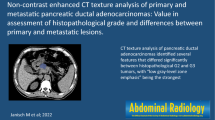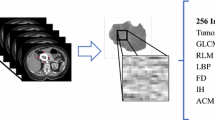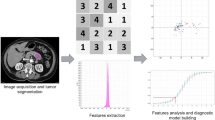Abstract
Objective
To develop diagnostic radiomic model–based algorithm for pancreatic ductal adenocarcinoma (PDAC) grade prediction.
Methods
Ninety-one patients with histologically confirmed PDAC and preoperative CT were divided into subgroups based on tumor grade. Two histology-blinded radiologists independently segmented lesions for quantitative texture analysis in all contrast enhancement phases. The ratio of densities of PDAC and unchanged pancreatic tissue, and relative tumor enhancement (RTE) in arterial, portal venous, and delayed phases of the examination were calculated. Principal component analysis was used for multivariate predictor analysis. The selection of predictors in the binary logistic model was carried out in 2 stages: (1) using one-factor logistic models (selection criterion was p < 0.1); (2) using regularization (LASSO regression after standardization of variables). Predictors were included in proportional odds models without interactions.
Results
There were significant differences in 4, 16, and 8 texture features out of 62 for the arterial, portal venous, and delayed phases of the study, respectively (p < 0.1). After selection, the final diagnostic model included such radiomics features as DISCRETIZED HU standard, DISCRETIZED HUQ3, GLCM Correlation, GLZLM LZLGE for the portal venous phase of the contrast enhancement, and CONVENTIONAL_HUQ3 for the delayed phase of CT study. On its basis, a diagnostic model was built, showing AUC for grade ≥ 2 of 0.75 and AUC for grade 3 of 0.66.
Conclusion
Radiomics features vary in PDAC of different grades and increase the accuracy of CT in preoperative diagnosis. We have developed a diagnostic model, including texture features, which can be used to predict the grade of PDAC.
Key Points
• A diagnostic algorithm based on CT texture features for preoperative PDAC grade prediction was developed.
• The assumption that the scanning protocol can influence the results of texture analysis was confirmed and assessed.
• Our results show that tumor differentiation grade can be assessed with sufficient diagnostic accuracy using CT texture analysis presented in this study.






Similar content being viewed by others
Abbreviations
- 3D ROI:
-
Three-dimensional region of interest
- AUC:
-
Area under the curve
- CAP:
-
College of American Pathologists
- CE:
-
Contrast enhancement
- CECT:
-
Contrast-enhanced computed tomography
- CM:
-
Contrast media
- CT:
-
Computed tomography
- DRI:
-
DoseRight software
- HU:
-
Hounsfield units
- MRI:
-
Magnetic resonance imaging
- PDAC:
-
Pancreatic ductal adenocarcinoma
- ROC:
-
Receiver operating characteristic
- ROI:
-
Region of interest
- RTE:
-
Relative tumor enhancement
- VIF:
-
Variance inflation factor
References
Vincent A, Herman J, Schulick R, Hruban RH, Goggins M (2011) Pancreatic cancer. Lancet 378:607–620. Available at: https://pubmed.ncbi.nlm.nih.gov/21620466/. Accessed 2 Oct 2020
Stark AP, Sacks GD, Rochefort MM et al (2016) Long-term survival in patients with pancreatic ductal adenocarcinoma. Surgery 159:1520–1527. https://doi.org/10.1016/j.surg.2015.12.024
Golan T, Sella T, Margalit O et al (2017) Short- and long-term survival in metastatic pancreatic adenocarcinoma, 1993-2013. J Natl Compr Canc Netw 15:1022–1027. https://doi.org/10.6004/jnccn.2017.0138
Han SH, Heo JS, Choi SH et al (2017) Actual long-term outcome of T1 and T2 pancreatic ductal adenocarcinoma after surgical resection. Int J Surg. 40:68–72. https://doi.org/10.1016/j.ijsu.2017.02.007
Liu L, Xu HX, He M, et al (2018) A novel scoring system predicts postsurgical survival and adjuvant chemotherapeutic benefits in patients with pancreatic adenocarcinoma: implications for AJCC-TNM staging. Surgery 163:1280–1294. https://doi.org/10.1016/j.surg.2018.01.017
Nurmi A, Mustonen H, Parviainen H, Peltola K, Haglund C, Seppanen H (2018) Neoadjuvant therapy offers longer survival than upfront surgery for poorly differentiated and higher stage pancreatic cancer. Acta Oncol. 57(6):799–806. https://doi.org/10.1080/0284186X.2017.1415458
Eloubeidi MA, Tamhane A, Varadarajulu S, Wilcox CM (2006) Frequency of major complications after EUS-guided FNA of solid pancreatic masses: a prospective evaluation. Gastrointest Endosc 63:622–629. https://doi.org/10.1016/j.gie.2005.05.024
Gerlinger M, Rowan AJ, Horswell S et al (2012) Intratumor heterogeneity and branched evolution revealed by multiregion sequencing. N Engl J Med 366:883–892. https://doi.org/10.1056/NEJMoa1113205
Treadwell JR, Zafar HM, Mitchell MD, Tipton K, Teitelbaum U, Jue J (2016) Imaging tests for the diagnosis and staging of pancreatic adenocarcinoma: a meta-analysis. Pancreas 45(6):789–795. Available at: https://pubmed.ncbi.nlm.nih.gov/26745859/. Accessed 2 Oct 2020
Goyen M (2014) Radiogenomic imaging-linking diagnostic imaging and molecular diagnostics. World J Radiol 6(8):519. Available at: /pmc/articles/PMC4147432/?report=abstract. Accessed 2 Oct 2020
Machicado JD, Koay EJ, Krishna SG (2020) Radiomics for the diagnosis and differentiation of pancreatic cystic lesions. Diagnostics 10(7):505. Available at: https://www.mdpi.com/2075-4418/10/7/505. Accessed 2 Oct 2020
Parekh V, Jacobs MA (2016) Radiomics: a new application from established techniques. Expert Rev Precis Med Drug Dev 1(2):207–226. Available at: https://pubmed.ncbi.nlm.nih.gov/28042608/. Accessed 2 Oct 2020
Diehl SJ, Lehmann KJ, Sadick M, Lachmann R, Georgi M (1998) Pancreatic cancer: value of dual-phase helical CT in assessing resectability. Radiology 206(2):373–378
Tamm EP, Bhosale PR, Lee JH (2007) Pancreatic ductal adenocarcinoma: ultrasound, computed tomography, and magnetic resonance imaging features. Semin Ultrasound CT MRI 28(5):330–338
Yamashita R, Perrin T, Chakraborty J et al (2020) cRadiomic feature reproducibility in contrast-enhanced CT of the pancreas is affected by variabilities in scan parameters and manual segmentation. Eur Radiol 30(1):195–205. Available at: https://pubmed.ncbi.nlm.nih.gov/31392481/. Accessed 2 Oct 2020
Eilaghi A, Baig S, Zhang Y et al (2017) CT texture features are associated with overall survival in pancreatic ductal adenocarcinoma - a quantitative analysis. BMC Med Imaging. 17(1):1–7
Sandrasegaran K, Lin Y, Asare-Sawiri, Taiyini T, Tann M (2019) CT texture analysis of pancreatic cancer. Eur Radiol 29(3):1067–1073. Available at: http://link.springer.com/10.1007/s00330-018-5662-1. Accessed 2 Oct 2020
Kulkarni A, Carrion-Martinez I, Jiang NN et al (2020) Hypovascular pancreas head adenocarcinoma: CT texture analysis for assessment of resection margin status and high-risk features. Eur Radiol 30(5):2853–2860. Available at: https://pubmed.ncbi.nlm.nih.gov/31953662/. Accessed 5 Oct 2020
Yun G, Kim YH, Lee YJ, Kim B, Hwang JH, Choi DJ (2018) Tumor heterogeneity of pancreas head cancer assessed by CT texture analysis: association with survival outcomes after curative resection. Sci Rep 8(1):1–10. Available at: www.nature.com/scientificreports. Accessed 2 Oct 2020
Fang WH, Li XD, Zhu H et al (2020) Resectable pancreatic ductal adenocarcinoma: association between preoperative CT texture features and metastatic nodal involvement. Cancer Imaging. 20(1):1–10
Nioche C, Orlhac F, Boughdad S et al (2018) LifEx: a freeware for radiomic feature calculation in multimodality imaging to accelerate advances in the characterization of tumor heterogeneity. Cancer Res 78(16):4786–4789. Available at: https://pubmed.ncbi.nlm.nih.gov/29959149/. Accessed 2 Oct 2020
Nagtegaal ID, Odze RD, Klimstra D, et al (2020) The 2019 WHO classification of tumours of the digestive system. Histopathology 76(2):182–188. Available at: https://pubmed.ncbi.nlm.nih.gov/31433515/. Accessed 2 Oct 2020
Kakar S, Shi C, Adsay N, Volkan et al (2017) Protocol for the examination of specimens from patients with carcinoma of the pancreas with guidance from the CAP Cancer and CAP Pathology Electronic Reporting Committees. Available at: www.cap.org/cancerprotocols. Accessed 2 Oct 2020
Steyerberg EW (2019) Clinical prediction models: a practical approach to development, validation, and updating. 2nd ed. 2019 edition. In: Place of publication not identified. Springer, pp 220–221 251-254
James G, Witten D, Hastie T, Tibshirani R (2013) An introduction to statistical learning: with applications in R. 1st ed. 2013, Corr. 7th printing 2017 edition. Springer, New York, pp 219–227
Harrell FE (2015) Regression modeling strategies: with applications to linear models, logistic and ordinal regression, and survival analysis. 2nd ed. 2015 edition. Springer, Cham Heidelberg New York, pp 209–212
Harrell FE (2015) Regression modeling strategies: with applications to linear models, logistic and ordinal regression, and survival analysis. 2nd ed. 2015 edition. Springer, Cham Heidelberg New York, pp 110–111
Harrell FE (2015) Regression modeling strategies: with applications to linear models, logistic and ordinal regression, and survival analysis. 2nd ed. 2015 edition. Springer, Cham Heidelberg New York, pp 8–10
Cassinotto C, Chong J, Zogopoulos G et al (2017) Resectable pancreatic adenocarcinoma: role of CT quantitative imaging biomarkers for predicting pathology and patient outcomes. Eur J Radiol 90:152–158. Available at: https://pubmed.ncbi.nlm.nih.gov/28583627/. Accessed 2 Oct 2020
Chang N, Cui L, Luo Y, Chang Z, Yu B, Liu Z (2020) Development and multicenter validation of a CT-based radiomics signature for discriminating histological grades of pancreatic ductal adenocarcinoma //Quantitative imaging in medicine and surgery. – 2020. – Т. 10. – №. 3. – С. 692
Funding
The authors state that this work has not received any funding.
Author information
Authors and Affiliations
Corresponding author
Ethics declarations
Guarantor
The scientific guarantor of this publication is Amiran Sh. Revishvili.
Conflict of interest
The authors of this manuscript declare no relationships with any companies, whose products or services may be related to the subject matter of the article.
Statistics and biometry
One of the authors has significant statistical expertise.
Informed consent
Written informed consent was not required for this study because of its retrospective nature.
Ethical approval
Institutional Review Board approval was obtained.
Methodology
• retrospective
• diagnostic or prognostic study
• performed at one institution
Additional information
Publisher’s note
Springer Nature remains neutral with regard to jurisdictional claims in published maps and institutional affiliations.
Supplementary information
ESM 1
(DOCX 502 kb)
Rights and permissions
Springer Nature or its licensor holds exclusive rights to this article under a publishing agreement with the author(s) or other rightsholder(s); author self-archiving of the accepted manuscript version of this article is solely governed by the terms of such publishing agreement and applicable law.
About this article
Cite this article
Tikhonova, V.S., Karmazanovsky, G.G., Kondratyev, E.V. et al. Radiomics model–based algorithm for preoperative prediction of pancreatic ductal adenocarcinoma grade. Eur Radiol 33, 1152–1161 (2023). https://doi.org/10.1007/s00330-022-09046-1
Received:
Revised:
Accepted:
Published:
Issue Date:
DOI: https://doi.org/10.1007/s00330-022-09046-1




